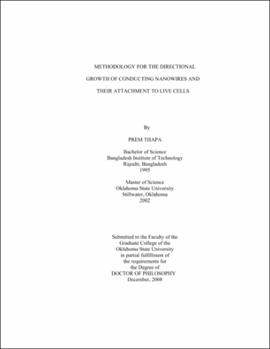| dc.contributor.advisor | Flanders, Bret N. | |
| dc.contributor.author | Thapa, Prem | |
| dc.date.accessioned | 2013-11-26T08:26:37Z | |
| dc.date.available | 2013-11-26T08:26:37Z | |
| dc.date.issued | 2008-12 | |
| dc.identifier.uri | https://hdl.handle.net/11244/6917 | |
| dc.description.abstract | Scope and Method of Study: | |
| dc.description.abstract | The purpose of this study was to develop a technique as an alternative approach for establishing cell-to-wire contact by the use of nanowire grown from Directed Electrochemical Nanowire Assembly (DENA) technique with weak perturbation to living cells. | |
| dc.description.abstract | Findings and Conclusions: | |
| dc.description.abstract | Methodology for the long-range growth of metallic and polymeric nanowires between on-chip electrodes has been established. Theoretical modelling reveals that there is a strong, long-range component of the applied potential that extends entirely across the gap between a user-chosen pair of electrodes. This component defines a vector of maximum ion-flux in the laboratory reference frame. For the metallic nanowires, this voltage-component tends to bring the crystallographic axis of growth into coincidence with the flux vector. For the polymeric nanowires, this channel of maximum ion flux restricts polymerization to the channel-region. Hence, amorphous materials may be grown with wire-like geometries, and the growth-path of the wires may be controlled. These wire-laden chips are useful substrates for cell physiological studies. To this end, the electrotactical behavior of Dictyostelium discoideum cells has been exploited to induce the formation of strong mechanical contacts between individual pseudopodia and the tips of biased polymeric wires in a manner that is only weakly perturbative to the cells. This capability is expected to facilitate electro-mechanical probing of cellular processes. | |
| dc.format | application/pdf | |
| dc.language | en_US | |
| dc.rights | Copyright is held by the author who has granted the Oklahoma State University Library the non-exclusive right to share this material in its institutional repository. Contact Digital Library Services at lib-dls@okstate.edu or 405-744-9161 for the permission policy on the use, reproduction or distribution of this material. | |
| dc.title | Methodology for the directional growth of conducting nanowires and their attachment to live cells | |
| dc.contributor.committeeMember | Grischkowsky, Daniel R. | |
| dc.contributor.committeeMember | Mintmire, John | |
| dc.contributor.committeeMember | Ackerson, Bruce J. | |
| dc.contributor.committeeMember | Hadwiger, Jeffrey A. | |
| osu.filename | Thapa_okstate_0664D_10094.pdf | |
| osu.accesstype | Open Access | |
| dc.type.genre | Dissertation | |
| dc.type.material | Text | |
| dc.subject.keywords | cell-wire contact | |
| dc.subject.keywords | dena | |
| dc.subject.keywords | dictyostelium cell | |
| dc.subject.keywords | electrotaxis | |
| dc.subject.keywords | metallic nanowire | |
| dc.subject.keywords | polymeric nanowire | |
| thesis.degree.discipline | Photonics | |
| thesis.degree.grantor | Oklahoma State University | |
